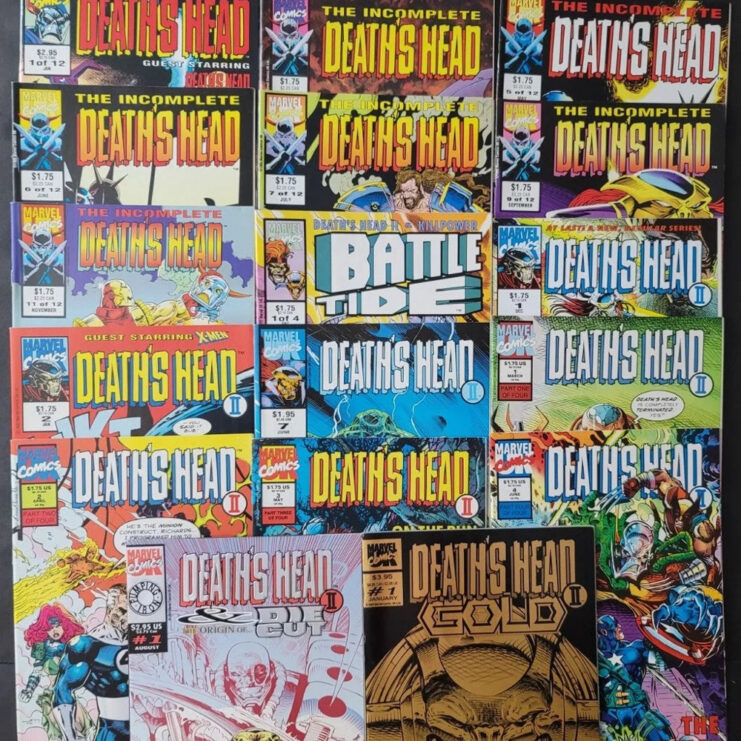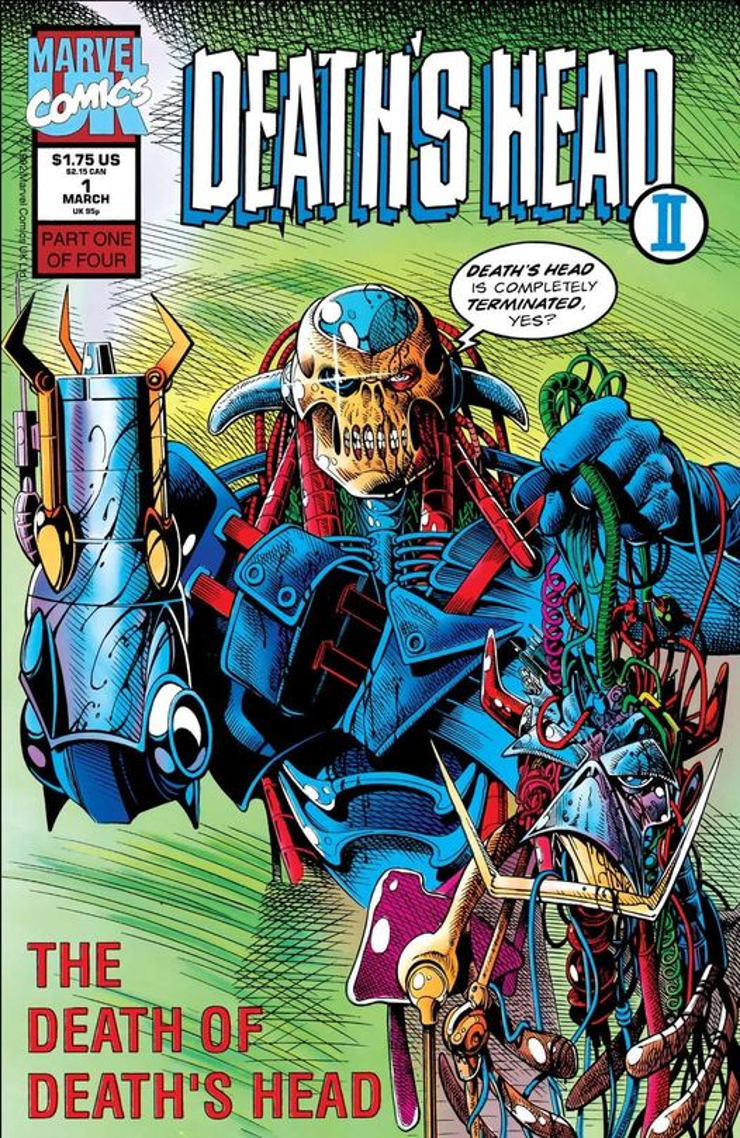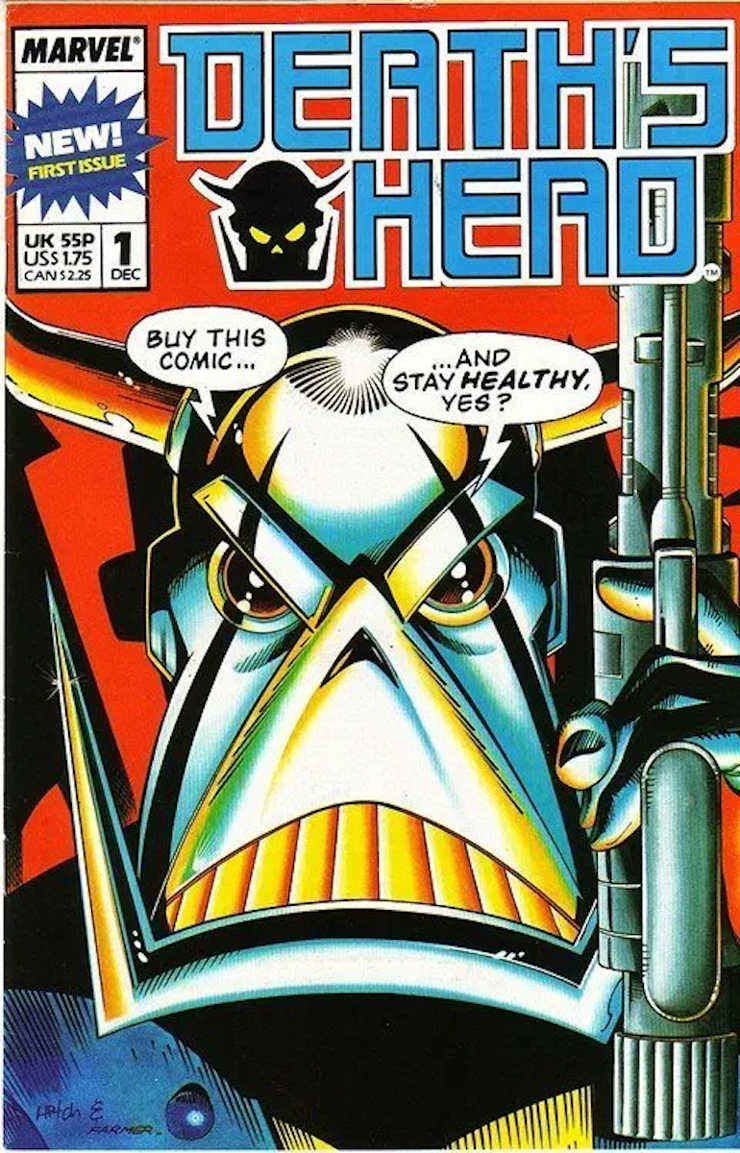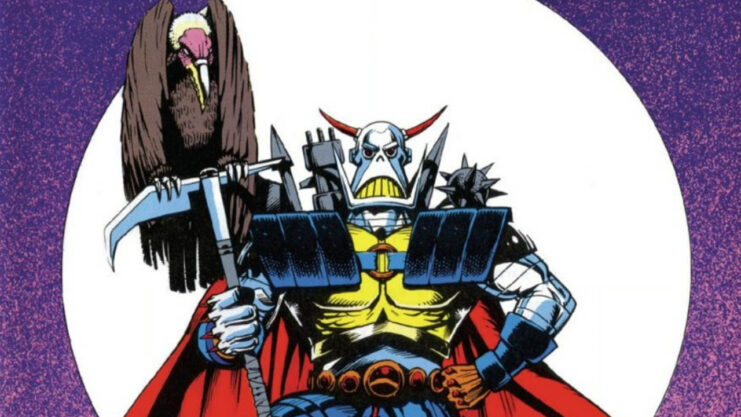He was named Minion, a creation of Advanced Idea Mechanics in the hopes of averting a mysterious threat from the future. He was sent through time and space to absorb the minds of the universe’s greatest scientists and warriors.
But due to absorbing the personality of a self-proclaimed freelance peacekeeping agent (i.e., bounty hunter) named Death’s Head, this hulking, high-powered cyborg was reborn, renamed and the time-spanning adventures of Death’s Head II came to be.

This year (today, in fact) marks the 30th Anniversary of the introduction of Death’s Head II. His look and style truly embodied the era in which he was created, with bulging muscles, reflective metal weapons, and pouches (oh, the ‘90s pouches). It’s a great time to look back on how the character has aged, and what his lasting effects were on the industry and his creator.
The original Death’s Head, created by Simon Furman for the Transformers UK comic in 1987, had been on the fringes of the Marvel Universe for years. In 1992, Marvel was looking to revamp some characters while at the same time launching a new imprint. First up, the ‘Big Guns’ promotion saw the introduction of the new Punisher: War Zone, Silver Sable and the Wild Pack, a new look for Luke Cage (calling him simply Cage), and a creepy body-collecting assassin named Terror Inc. At the same time the Marvel UK imprint, with location-specific heroes like Dark Angel, Motormouth & Killpower, and the Knights of Pendragon, was planning a concurrent launch. Death’s Head II became an icon for both the revamped Big Guns, and the flagship character for Marvel UK that year.
Artist/writer Liam Sharp, who recently finished acclaimed runs on DC’s Green Lantern and Wonder Woman, took some time out of preparing to release his Arthurian legend comic Starhenge to remember what went into creating the look of this surprisingly popular character. “It was entirely my design,” Sharp recalls. “Paul Neary had been showing me some rough sketches for a potential update and that night I faxed him a sketch saying something along the lines of ‘I always thought DH should look something like this…’
He called me in the next day and pretty much gave me the job on the spot – a complete redesign, input on the story, everything… I was gobsmacked! I’d had a terrible year struggling with work and financial issues and nothing had been going right, and then this landed in my lap! It would prove to be life-changing.”

Indeed, save for the blue/yellow/red color scheme, very little of the original Death’s Head could be seen in the redesign. Sharply pulled inspiration from a variety of sources. “Paul (Neary) had shown me some Jim Lee work, which I fell in love with … Then it was the Marvel house style – people think of it as the Image style, but Image had yet to be formed when I first started on DHII.
Jim, (Rob) Liefield, (Todd) McFarlane and (Marc) Silvestri were all still at Marvel doing amazing work. So that informed the style – along with some (Simon) Bisley influence and Barry Windsor Smith – while the design was very much a mash-up of Predator and Terminator, which were both HUGE at the time.”
The character launched in a four-issue limited series that hit immediately. Less than a year later a regular ongoing series appeared and lasted 16 issues – slightly longer than any other Marvel UK title. It was clear they had made something memorable. When asked how surprised he was at the success of Death’s Head II, Sharp replied: “We were ALL blown away. It was magical and exciting and created a huge buzz at Marvel UK. There was a real bullpen feel… Wonderful times.”

The surge in Death’s Head II’s popularity lasted for a few years in the early ‘90s. He met the likes of the X-Men, Captain America, Captain Britain, and the Punisher and battled villains throughout time. But, as it happens with popular characters, over-saturation can strike a swift and devastating blow.
The Marvel UK imprint failed to hit the hoped-for numbers and ceased releasing comics in the US in 1994. The characters were quietly shuffled aside. But that shining moment in time, on a personal note, was a boon for Sharp. “Without it, I’m not sure I would have had a career in the US,” Sharp admits. “It’s incredibly hard to get seen and rise above the noise. So, I have a huge fondness and nostalgia for the character. As I said – life-changing!”
This year, 30 years ago, my break-out comic Death’s Head II was published by Marvel UK and broke a ton of sales records, changing my life forever. Here’s my little tribute to that moment in time, and a fond spoof of the 90’s!
Happy 30th birthday Death’s Head II and Tuck! xoxox pic.twitter.com/veMGih1zXH— Liam ‘Sharpy’ Sharp (@LiamRSharp) January 14, 2022
In total, Death’s Head II has appeared in over 150 comic books and crossovers, just slightly less than his predecessor who tops in around 190. Although it’s been a few years since Death’s Head II saw print in a Marvel comic. Sharp recently created, drew, and posted a two-page anniversary ‘issue’ of Death’s Head II on Twitter as a personal celebration of the character, which can be seen above. Although he might seem a little dated to modern comic audiences, Death’s Head II still stands as a unique hero of the ’90s who will almost certainly pop up again in one form or another.

